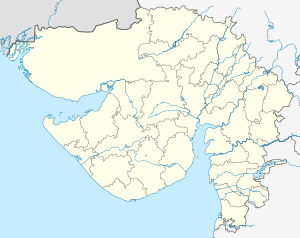Dholka is a city and municipality in the Ahmedabad District of the Indian state of Gujarat. It is the headquarters of Dholka Taluka, and is 48 km by road via National Highway 8A southwest of the city of Ahmedabad. Dholka has an average elevation of 17 metres (56 ft). Dholka's Nearest City is Ahmedabad and Kheda.

Champaner-Pavagadh Archaeological Park, a UNESCO World Heritage Site, is located in Panchmahal district in Gujarat, India. It is located around the historical city of Champaner, a city which was founded by Vanraj Chavda, the most prominent king of the Chavda Dynasty, in the eighth century. He named it after the name of his friend and general Champa, also known later as Champaraj. The heritage site is studded with forts with bastions starting from the hills of Pavagadh, and extending into the city of Champaner. The park's landscape includes archaeological, historic and living cultural heritage monuments such as chalcolithic sites, a hill fortress of an early Hindu capital, and remains of the 16th-century capital of the state of Gujarat. There are palaces, entrance gates and arches, mosques, tombs and temples, residential complexes, agricultural structures and water installations such as stepwells and tanks, dating from the eighth to the 14th centuries. The Kalika Mata Temple, located on top of the 800 metres (2,600 ft) high Pavagadh Hill, is an important Hindu shrine in the region, attracting large numbers of pilgrims throughout the year.
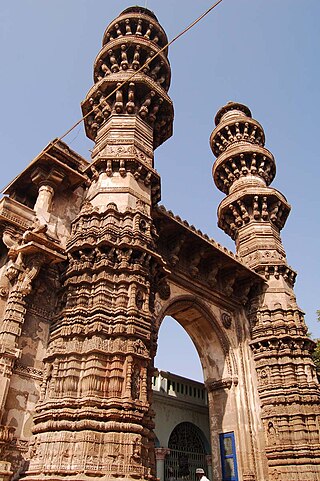
Jhulta Minar, meaning 'Swaying Twin Minarets', a part of the Siddi Bashir Mosque in Ahmedabad, Gujarat, is an engineering marvel of Islamic architecture built in the year 1461. The 3-storey tall structure, with intricate designs on each minaret, is famous for its built-in quality of swaying to the minimum force applied to its uppermost arc. A gentle shaking of either minaret results in the vibration of the other minaret after a few seconds, though the connecting passage remains free of any vibration. This unconventional structure still remains a mystery, unsolved by engineers world over. According to popular belief, the Jhulta Minar was built to receive early signals of earthquakes.

Jamali Kamali Mosque and Tomb, located in the Archaeological Village complex in Mehrauli, Delhi, India, comprise two monuments adjacent to each other; one is the mosque and the other is the tomb of Jamali and Kamali. Their names are tagged together as "Jamali Kamali" for the mosque as well as the tomb since they are buried adjacent to each other. The mosque and the tomb were constructed in 1528-1529, and Jamali was buried in the tomb after his death in 1535.

Jama Masjid, also known as Jumah Mosque or Jami' Masjid, is a mosque in Ahmedabad, Gujarat, India. It was built in 1424 during the reign of Ahmad Shah I. The inscription on the central mihrab commemorates the inauguration of the mosque on the 1st Safar A.H. 827 or January 4, 1424 A.D. by Sultan Ahmad Shah I. The mosque lies in the old walled city, and it is situated outside Bhadra Fort area. The old walled city is divided into separate quarters or pols, and the Jami' Masjid is found on the Gandhi Road. Along the south side of the road, the mosque is a short distance beyond the Teen Darwaza or Tripolia Gate.
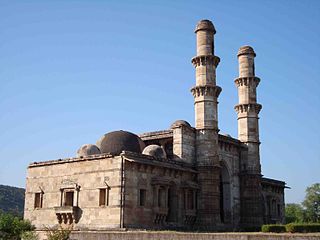
Kevada Mosque is a mosque in Champaner, Gujarat state, western India. It is part of the Champaner-Pavagadh Archaeological Park, a UNESCO World Heritage Site. The mosque has minarets, globe-like domes, and narrow stairs. According to Ruggles (2008), the "built temple reified natural form" and nature was integrated into the Kevada mosque's architecture in a way that was unusual elsewhere in the Islamic world.

Bawaman Mosque is a mosque in Champaner, western India. It is situated on the western side of one of the ancient city's fort gates, within the Champaner-Pavagadh Archaeological Park of Gujarat.

There are eleven different types of buildings at the UNESCO-protected Champaner-Pavagadh Archaeological Park in Gujarat, India, including mosques, temples, granaries, tombs, wells, walls, and terraces. The monuments are situated at the foot of and around the Pavagadh Hill. The Baroda Heritage Trust lists 114 monuments in the area, of which only 39 are maintained by the Archaeological Survey of India, due to limited funding. The Forest Department owns 94% of the land here, while the temple trusts and other sectarian establishments provide facilities for boarding and lodging to pilgrims and tourists. On the southern side near the foot of the hill some dilapidated houses and the foundations of Jain temples can also be seen.

Lila Gumbaj Ki Mosque in Champaner, Gujarat state, western India is one of the 114 monuments listed by the Baroda Heritage Trust that are part of the Champaner-Pavagadh Archaeological Park, a UNESCO World Heritage Site. It is located near the east gate of the former city.
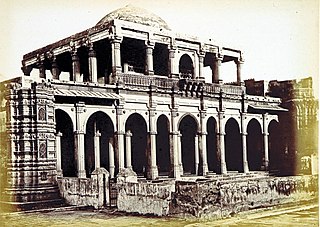
Shahpur Mosque, also known as Shahpur Paththarwali Masjid or Kazi Mohammed Chishti's Mosque, is a medieval mosque located near Shahpur Gate in Ahmedabad, India.

Saiyad Usman Mosque, alternatively spelled as Syed or Saiyyed, also known as Usmanpura Dargah or Roza or Saiyad Oosman Mausoleum, is a medieval tomb and mosque in Usmanpura, Ahmedabad, India.

Achut Bibi's Mosque and Tomb, also known as Shahi Masjid locally, is a medieval mosque and tomb complex on the bank of Sabarmati river in Dudheshwar, Ahmedabad, India.

Miya Khan Chishti's Mosque and Tomb is a medieval mosque and tomb complex on the bank of Sabarmati river in Shahibaug area of Ahmedabad, India.

Malik Alam's Mosque, also known as Peer Kamaal's Mosque, is a medieval mosque in the Shah Alam area of Ahmedabad, India.

Shah-e-Alam's Tomb and Mosque, also known as Rasulabad Dargah or Shah Alam no Rozo, is a medieval mosque and tomb complex (Roza) in Shah Alam area of Ahmedabad, India.

Rani Rupamati's Mosque, also known as Rani Rupavati's Mosque or Mirzapur Queen's Mosque, is a medieval mosque and tomb complex in Mirzapur area of Ahmedabad, India.

Baba Lului's Mosque, also known as Baba Lavlavie's Masjid, is a medieval mosque and tomb complex in Behrampura area of Ahmedabad, India.
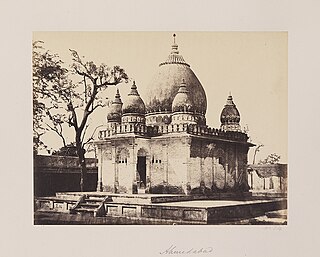
Sardar Khan's Roza or Nawab Sardar Khan's Mosque and Tomb, is a mosque and tomb complex in Jamalpur area of Ahmedabad, Gujarat, India.

Adhai Din Ka Jhonpra is a historical mosque in the city of Ajmer in Rajasthan, India. It is one of the oldest mosques in India, and the oldest surviving monument in Ajmer.

Jumma Masjid or Jama Masjid is a mosque in Uparkot Fort in Junagadh, Gujarat, India. The mosque was built in 15th century by converting a temple or a palace identified as Ranakdevi Mahal by local people and ASI. There is a controversy surrounding the identification of the structure.



